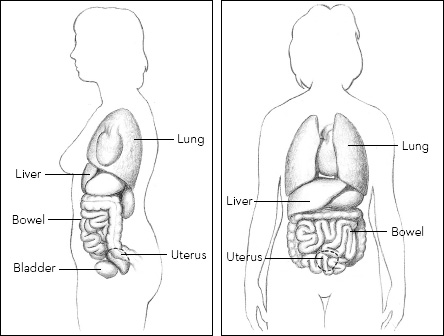2. Stretch Marks
Stretch marks, also called striae distensae,
may occur more often in older women. These marks occur when the elastic
fibers and collagen in deeper layers of your skin are pulled apart to
make room for baby. When skin tears, collagen breaks down and shows
through the top layer of skin as a pink, red or purple indented streak.
Nearly 9 out of 10 pregnant women develop
stretch marks on their breasts, tummy, hips, buttocks and/or arms. They
may appear any time during pregnancy. After birth, they may fade to the
same color as the rest of your skin, but they won’t go away completely.
To date, no one has found a reliable way
of avoiding stretch marks. Women have tried many lotions, creams and
other remedies, with little success. There is no harm in using lotion
products, but they probably won’t prevent you from getting stretch
marks.

During the first trimester, you will notice few changes in your body.
You can help yourself by gaining weight slowly and steadily during pregnancy. Any large increase in weight can cause stretch marks to appear more readily.
Drink lots of water, and eat healthy
foods. Foods high in antioxidants provide nutrients needed to repair
and to heal tissue. Eating enough protein and smaller amounts of “good”
fats, such as flaxseed, flaxseed oil and fish oils, may also help you.
Stay out of the sun! Keep up with your exercise program.
Ask your healthcare provider about using
creams with alpha-hydroxy acid, citric acid or lactic acid. Some of
these creams and lotions improve the quality of the skin’s elastic
fibers.
Don’t use steroid creams, such as
hydrocortisone or topicort, to treat stretch marks during pregnancy
without first checking with your healthcare provider. You absorb some
of the steroid into your system, and it can pass to baby. And stretch
creams really can’t penetrate deeply enough to repair damage to your
skin.

Your body undergoes fantastic changes
later in pregnancy. Close to delivery, your uterus takes up a great
deal of room and “rearranges” various organs.
Some additional treatments may
help after baby is born. Retin-A or Renova, used in combination with
glycolic acid, is fairly effective. Prescriptions are needed for
Retin-A and Renova; you can get glycolic acid from your dermatologist.
Cellex-C, with glycolic acid, also improves the appearance of stretch
marks. The most effective treatment—but the most costly—is laser
treatment. This is often done in combination with the medication
methods described above. All of these treatments are done after pregnancy.